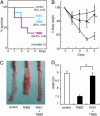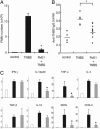Resolvin E1, an endogenous lipid mediator derived from omega-3 eicosapentaenoic acid, protects against 2,4,6-trinitrobenzene sulfonic acid-induced colitis
- PMID: 15890784
- PMCID: PMC1103706
- DOI: 10.1073/pnas.0409271102
Resolvin E1, an endogenous lipid mediator derived from omega-3 eicosapentaenoic acid, protects against 2,4,6-trinitrobenzene sulfonic acid-induced colitis
Abstract
Resolvin E1 (RvE1; 5S,12R,18R-trihydroxyeicosapentaenoic acid) is an antiinflammatory lipid mediator derived from omega-3 fatty acid eicosapentaenoic acid (EPA). At the local site of inflammation, aspirin treatment enhances EPA conversion to 18R-oxygenated products, including RvE1, which carry potent antiinflammatory signals. Here, we obtained evidence for reduced leukocyte infiltration in a mouse peritonitis model, where the administration of EPA and aspirin initiated the generation of RvE1 in the exudates. Similar results were obtained with the administration of synthetic RvE1, which blocked leukocyte infiltration. RvE1 also protected against the development of 2,4,6-trinitrobenzene sulfonic acid-induced colitis. The beneficial effect was reflected by increased survival rates, sustained body weight, improvement of histologic scores, reduced serum anti-2,4,6-trinitrobenzene sulfonic acid IgG, decreased leukocyte infiltration, and proinflammatory gene expression, including IL-12 p40, TNF-alpha, and inducible nitric oxide synthase. Thus, the endogenous lipid mediator RvE1 counter-regulates leukocyte-mediated tissue injury and proinflammatory gene expression. These findings show an endogenous mechanism that may underlie the beneficial actions of omega-3 EPA and provide targeted approaches for the treatment of intestinal inflammation.
Figures





References
-
- Libby, P. (2002) Nature 420, 868–874. - PubMed
-
- Gruppo Italiano per lo Studio della Streptochinasi nell'Infarto Miocardico (GISSI)-Prevenzione Investigators (1999) Lancet 354, 447–455. - PubMed
-
- Freedman, S. D., Blanco, P. G., Zaman, M. M., Shea, J. C., Ollero, M., Hopper, I. K., Weed, D. A., Gelrud, A., Regan, M. M., Lapostata, M., et al. (2004) N. Engl. J. Med. 350, 560–569. - PubMed
-
- Belluzzi, A., Brignola, C., Campieri, M., Pera, A., Boschi, S. & Miglioli, M. (1996) N. Engl. J. Med. 334, 1557–1560. - PubMed
-
- Teitelbaum, J. E. & Walker, W. A. (2001) J. Nutr. Biochem. 12, 21–32. - PubMed
Publication types
MeSH terms
Substances
Grants and funding
LinkOut - more resources
Full Text Sources
Other Literature Sources
Medical
Research Materials

